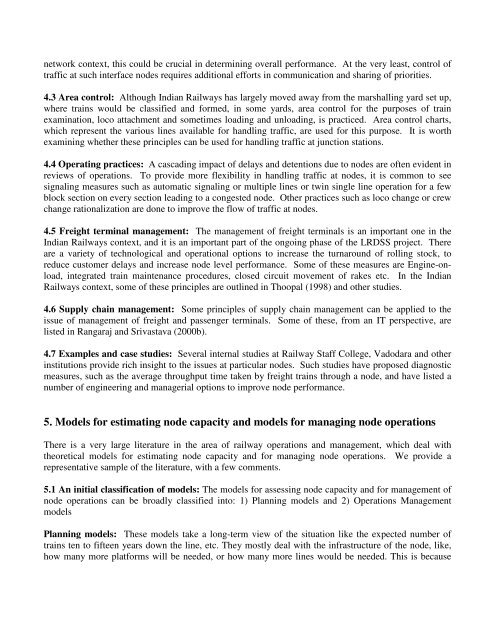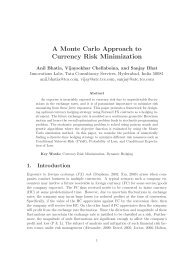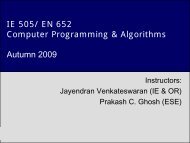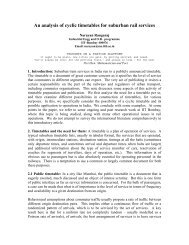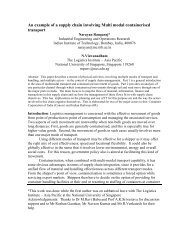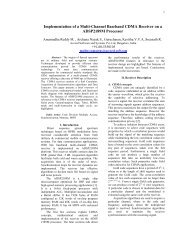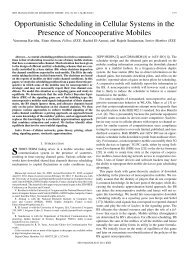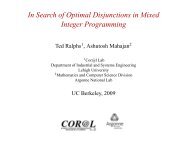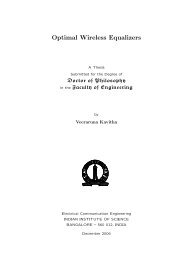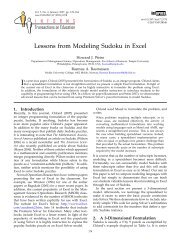Node capacity and terminal management on Indian Railways
Node capacity and terminal management on Indian Railways
Node capacity and terminal management on Indian Railways
Create successful ePaper yourself
Turn your PDF publications into a flip-book with our unique Google optimized e-Paper software.
network c<strong>on</strong>text, this could be crucial in determining overall performance. At the very least, c<strong>on</strong>trol of<br />
traffic at such interface nodes requires additi<strong>on</strong>al efforts in communicati<strong>on</strong> <str<strong>on</strong>g>and</str<strong>on</strong>g> sharing of priorities.<br />
4.3 Area c<strong>on</strong>trol: Although <strong>Indian</strong> <strong>Railways</strong> has largely moved away from the marshalling yard set up,<br />
where trains would be classified <str<strong>on</strong>g>and</str<strong>on</strong>g> formed, in some yards, area c<strong>on</strong>trol for the purposes of train<br />
examinati<strong>on</strong>, loco attachment <str<strong>on</strong>g>and</str<strong>on</strong>g> sometimes loading <str<strong>on</strong>g>and</str<strong>on</strong>g> unloading, is practiced. Area c<strong>on</strong>trol charts,<br />
which represent the various lines available for h<str<strong>on</strong>g>and</str<strong>on</strong>g>ling traffic, are used for this purpose. It is worth<br />
examining whether these principles can be used for h<str<strong>on</strong>g>and</str<strong>on</strong>g>ling traffic at juncti<strong>on</strong> stati<strong>on</strong>s.<br />
4.4 Operating practices: A cascading impact of delays <str<strong>on</strong>g>and</str<strong>on</strong>g> detenti<strong>on</strong>s due to nodes are often evident in<br />
reviews of operati<strong>on</strong>s. To provide more flexibility in h<str<strong>on</strong>g>and</str<strong>on</strong>g>ling traffic at nodes, it is comm<strong>on</strong> to see<br />
signaling measures such as automatic signaling or multiple lines or twin single line operati<strong>on</strong> for a few<br />
block secti<strong>on</strong> <strong>on</strong> every secti<strong>on</strong> leading to a c<strong>on</strong>gested node. Other practices such as loco change or crew<br />
change rati<strong>on</strong>alizati<strong>on</strong> are d<strong>on</strong>e to improve the flow of traffic at nodes.<br />
4.5 Freight <str<strong>on</strong>g>terminal</str<strong>on</strong>g> <str<strong>on</strong>g>management</str<strong>on</strong>g>: The <str<strong>on</strong>g>management</str<strong>on</strong>g> of freight <str<strong>on</strong>g>terminal</str<strong>on</strong>g>s is an important <strong>on</strong>e in the<br />
<strong>Indian</strong> <strong>Railways</strong> c<strong>on</strong>text, <str<strong>on</strong>g>and</str<strong>on</strong>g> it is an important part of the <strong>on</strong>going phase of the LRDSS project. There<br />
are a variety of technological <str<strong>on</strong>g>and</str<strong>on</strong>g> operati<strong>on</strong>al opti<strong>on</strong>s to increase the turnaround of rolling stock, to<br />
reduce customer delays <str<strong>on</strong>g>and</str<strong>on</strong>g> increase node level performance. Some of these measures are Engine-<strong>on</strong>load,<br />
integrated train maintenance procedures, closed circuit movement of rakes etc. In the <strong>Indian</strong><br />
<strong>Railways</strong> c<strong>on</strong>text, some of these principles are outlined in Thoopal (1998) <str<strong>on</strong>g>and</str<strong>on</strong>g> other studies.<br />
4.6 Supply chain <str<strong>on</strong>g>management</str<strong>on</strong>g>: Some principles of supply chain <str<strong>on</strong>g>management</str<strong>on</strong>g> can be applied to the<br />
issue of <str<strong>on</strong>g>management</str<strong>on</strong>g> of freight <str<strong>on</strong>g>and</str<strong>on</strong>g> passenger <str<strong>on</strong>g>terminal</str<strong>on</strong>g>s. Some of these, from an IT perspective, are<br />
listed in Rangaraj <str<strong>on</strong>g>and</str<strong>on</strong>g> Srivastava (2000b).<br />
4.7 Examples <str<strong>on</strong>g>and</str<strong>on</strong>g> case studies: Several internal studies at Railway Staff College, Vadodara <str<strong>on</strong>g>and</str<strong>on</strong>g> other<br />
instituti<strong>on</strong>s provide rich insight to the issues at particular nodes. Such studies have proposed diagnostic<br />
measures, such as the average throughput time taken by freight trains through a node, <str<strong>on</strong>g>and</str<strong>on</strong>g> have listed a<br />
number of engineering <str<strong>on</strong>g>and</str<strong>on</strong>g> managerial opti<strong>on</strong>s to improve node performance.<br />
5. Models for estimating node <str<strong>on</strong>g>capacity</str<strong>on</strong>g> <str<strong>on</strong>g>and</str<strong>on</strong>g> models for managing node operati<strong>on</strong>s<br />
There is a very large literature in the area of railway operati<strong>on</strong>s <str<strong>on</strong>g>and</str<strong>on</strong>g> <str<strong>on</strong>g>management</str<strong>on</strong>g>, which deal with<br />
theoretical models for estimating node <str<strong>on</strong>g>capacity</str<strong>on</strong>g> <str<strong>on</strong>g>and</str<strong>on</strong>g> for managing node operati<strong>on</strong>s. We provide a<br />
representative sample of the literature, with a few comments.<br />
5.1 An initial classificati<strong>on</strong> of models: The models for assessing node <str<strong>on</strong>g>capacity</str<strong>on</strong>g> <str<strong>on</strong>g>and</str<strong>on</strong>g> for <str<strong>on</strong>g>management</str<strong>on</strong>g> of<br />
node operati<strong>on</strong>s can be broadly classified into: 1) Planning models <str<strong>on</strong>g>and</str<strong>on</strong>g> 2) Operati<strong>on</strong>s Management<br />
models<br />
Planning models: These models take a l<strong>on</strong>g-term view of the situati<strong>on</strong> like the expected number of<br />
trains ten to fifteen years down the line, etc. They mostly deal with the infrastructure of the node, like,<br />
how many more platforms will be needed, or how many more lines would be needed. This is because


